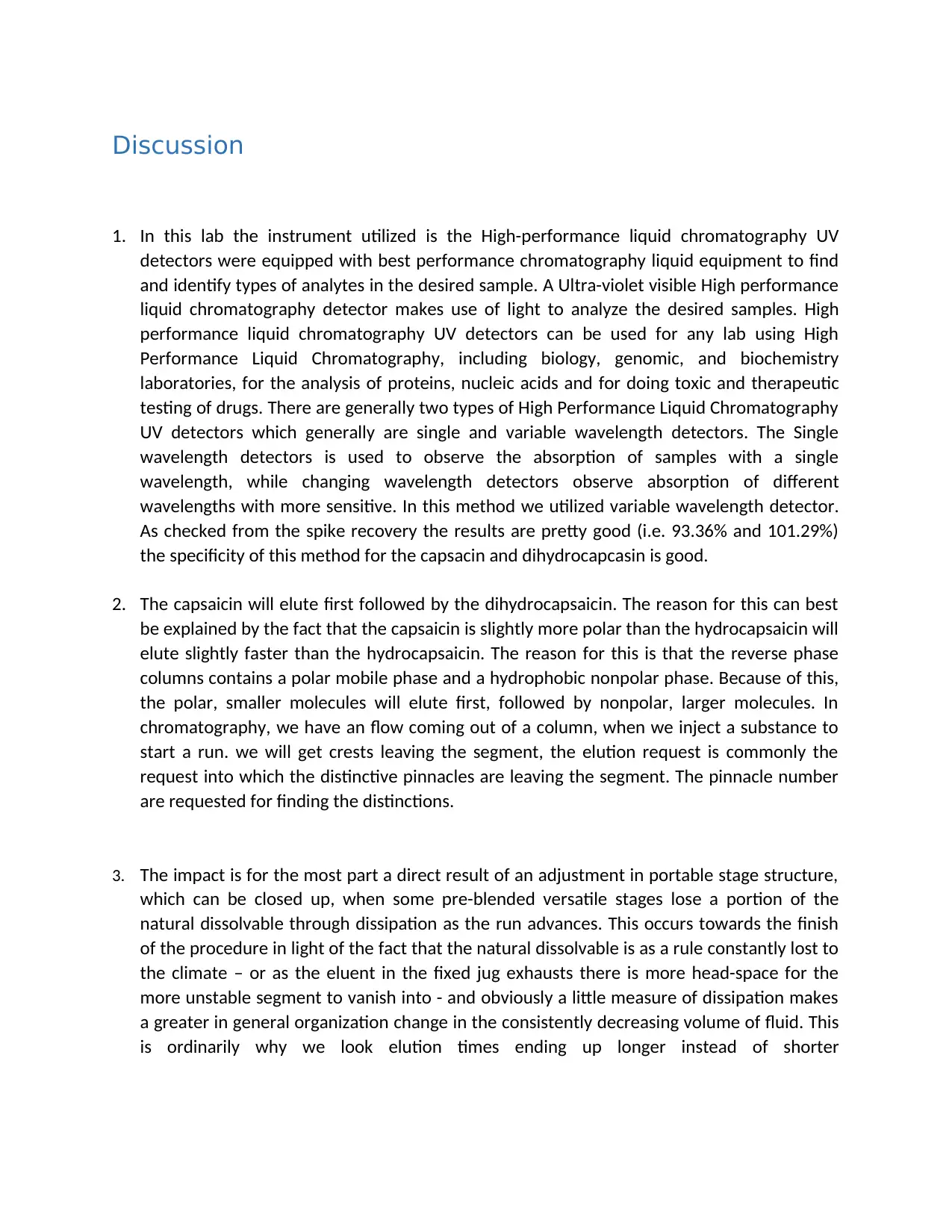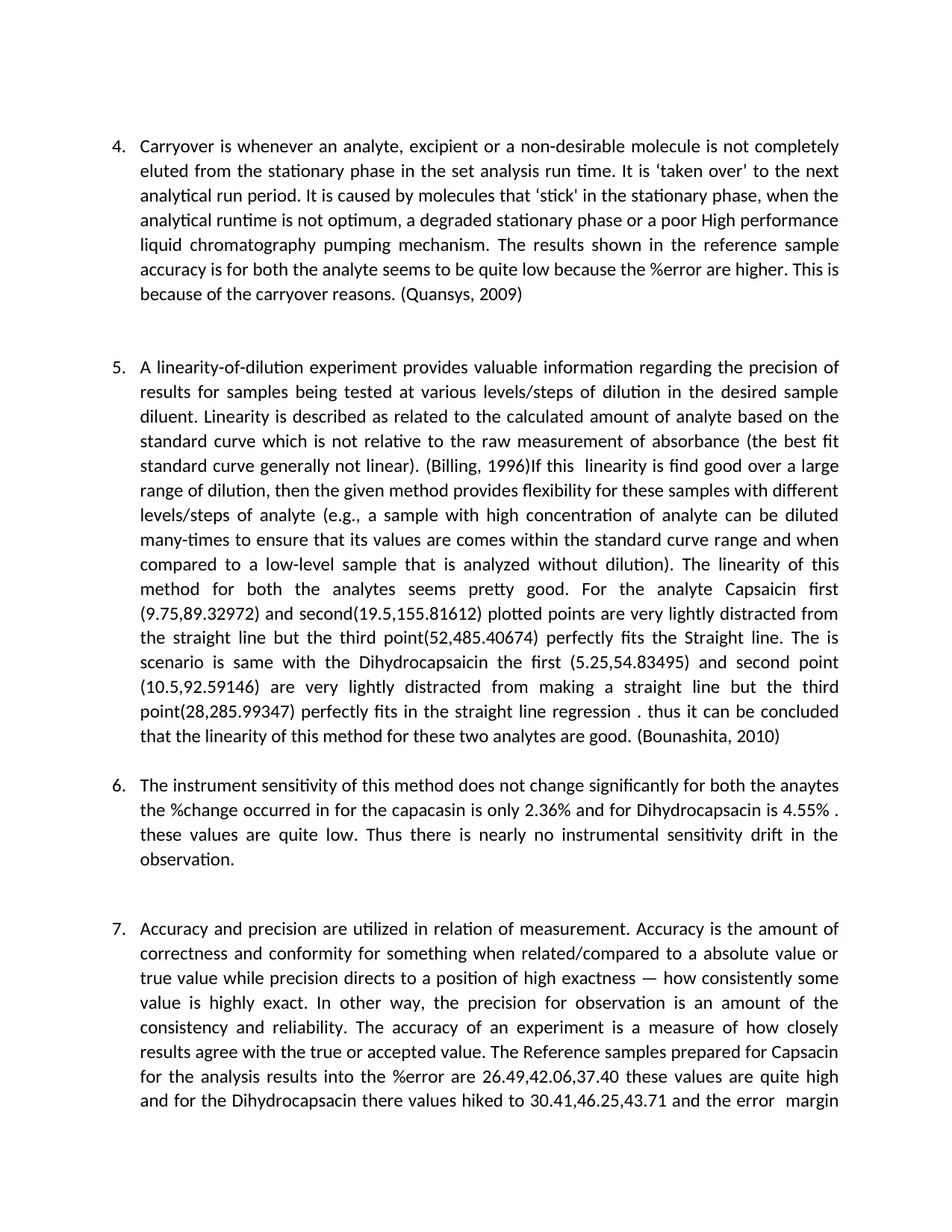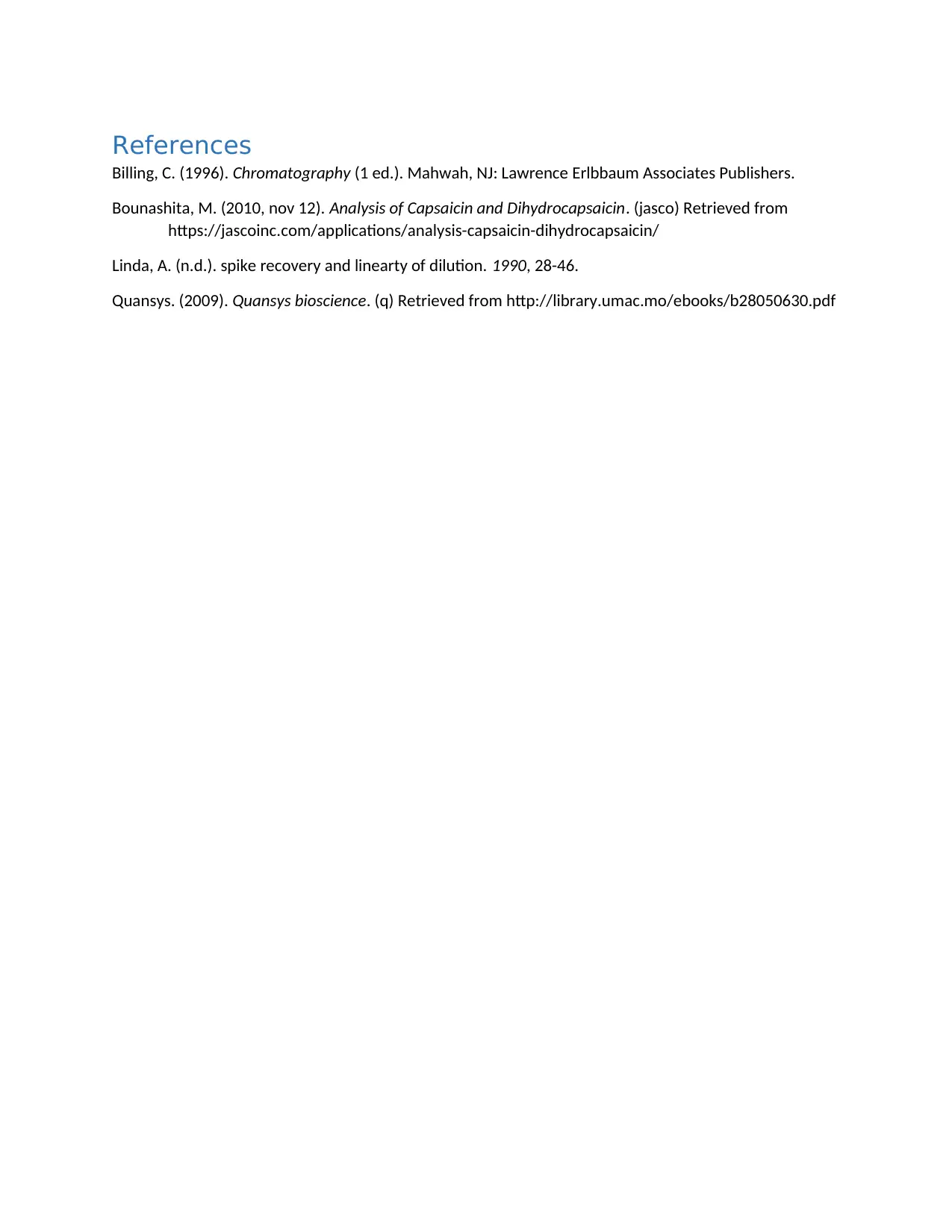High-performance liquid chromatography UV detectors and its application in analyzing analytes
VerifiedAdded on 2023/04/24
|4
|1268
|402
AI Summary
This article discusses the use of High-performance liquid chromatography UV detectors in analyzing analytes. It covers the types of detectors, elution order, carryover, linearity-of-dilution, instrument sensitivity, accuracy, and spike-and-recuperation. The results of the experiment are also analyzed and discussed.
Contribute Materials
Your contribution can guide someone’s learning journey. Share your
documents today.

Discussion
1. In this lab the instrument utilized is the High-performance liquid chromatography UV
detectors were equipped with best performance chromatography liquid equipment to find
and identify types of analytes in the desired sample. A Ultra-violet visible High performance
liquid chromatography detector makes use of light to analyze the desired samples. High
performance liquid chromatography UV detectors can be used for any lab using High
Performance Liquid Chromatography, including biology, genomic, and biochemistry
laboratories, for the analysis of proteins, nucleic acids and for doing toxic and therapeutic
testing of drugs. There are generally two types of High Performance Liquid Chromatography
UV detectors which generally are single and variable wavelength detectors. The Single
wavelength detectors is used to observe the absorption of samples with a single
wavelength, while changing wavelength detectors observe absorption of different
wavelengths with more sensitive. In this method we utilized variable wavelength detector.
As checked from the spike recovery the results are pretty good (i.e. 93.36% and 101.29%)
the specificity of this method for the capsacin and dihydrocapcasin is good.
2. The capsaicin will elute first followed by the dihydrocapsaicin. The reason for this can best
be explained by the fact that the capsaicin is slightly more polar than the hydrocapsaicin will
elute slightly faster than the hydrocapsaicin. The reason for this is that the reverse phase
columns contains a polar mobile phase and a hydrophobic nonpolar phase. Because of this,
the polar, smaller molecules will elute first, followed by nonpolar, larger molecules. In
chromatography, we have an flow coming out of a column, when we inject a substance to
start a run. we will get crests leaving the segment, the elution request is commonly the
request into which the distinctive pinnacles are leaving the segment. The pinnacle number
are requested for finding the distinctions.
3. The impact is for the most part a direct result of an adjustment in portable stage structure,
which can be closed up, when some pre-blended versatile stages lose a portion of the
natural dissolvable through dissipation as the run advances. This occurs towards the finish
of the procedure in light of the fact that the natural dissolvable is as a rule constantly lost to
the climate – or as the eluent in the fixed jug exhausts there is more head-space for the
more unstable segment to vanish into - and obviously a little measure of dissipation makes
a greater in general organization change in the consistently decreasing volume of fluid. This
is ordinarily why we look elution times ending up longer instead of shorter
1. In this lab the instrument utilized is the High-performance liquid chromatography UV
detectors were equipped with best performance chromatography liquid equipment to find
and identify types of analytes in the desired sample. A Ultra-violet visible High performance
liquid chromatography detector makes use of light to analyze the desired samples. High
performance liquid chromatography UV detectors can be used for any lab using High
Performance Liquid Chromatography, including biology, genomic, and biochemistry
laboratories, for the analysis of proteins, nucleic acids and for doing toxic and therapeutic
testing of drugs. There are generally two types of High Performance Liquid Chromatography
UV detectors which generally are single and variable wavelength detectors. The Single
wavelength detectors is used to observe the absorption of samples with a single
wavelength, while changing wavelength detectors observe absorption of different
wavelengths with more sensitive. In this method we utilized variable wavelength detector.
As checked from the spike recovery the results are pretty good (i.e. 93.36% and 101.29%)
the specificity of this method for the capsacin and dihydrocapcasin is good.
2. The capsaicin will elute first followed by the dihydrocapsaicin. The reason for this can best
be explained by the fact that the capsaicin is slightly more polar than the hydrocapsaicin will
elute slightly faster than the hydrocapsaicin. The reason for this is that the reverse phase
columns contains a polar mobile phase and a hydrophobic nonpolar phase. Because of this,
the polar, smaller molecules will elute first, followed by nonpolar, larger molecules. In
chromatography, we have an flow coming out of a column, when we inject a substance to
start a run. we will get crests leaving the segment, the elution request is commonly the
request into which the distinctive pinnacles are leaving the segment. The pinnacle number
are requested for finding the distinctions.
3. The impact is for the most part a direct result of an adjustment in portable stage structure,
which can be closed up, when some pre-blended versatile stages lose a portion of the
natural dissolvable through dissipation as the run advances. This occurs towards the finish
of the procedure in light of the fact that the natural dissolvable is as a rule constantly lost to
the climate – or as the eluent in the fixed jug exhausts there is more head-space for the
more unstable segment to vanish into - and obviously a little measure of dissipation makes
a greater in general organization change in the consistently decreasing volume of fluid. This
is ordinarily why we look elution times ending up longer instead of shorter
Secure Best Marks with AI Grader
Need help grading? Try our AI Grader for instant feedback on your assignments.

4. Carryover is whenever an analyte, excipient or a non-desirable molecule is not completely
eluted from the stationary phase in the set analysis run time. It is ‘taken over’ to the next
analytical run period. It is caused by molecules that ‘stick' in the stationary phase, when the
analytical runtime is not optimum, a degraded stationary phase or a poor High performance
liquid chromatography pumping mechanism. The results shown in the reference sample
accuracy is for both the analyte seems to be quite low because the %error are higher. This is
because of the carryover reasons. (Quansys, 2009)
5. A linearity-of-dilution experiment provides valuable information regarding the precision of
results for samples being tested at various levels/steps of dilution in the desired sample
diluent. Linearity is described as related to the calculated amount of analyte based on the
standard curve which is not relative to the raw measurement of absorbance (the best fit
standard curve generally not linear). (Billing, 1996)If this linearity is find good over a large
range of dilution, then the given method provides flexibility for these samples with different
levels/steps of analyte (e.g., a sample with high concentration of analyte can be diluted
many-times to ensure that its values are comes within the standard curve range and when
compared to a low-level sample that is analyzed without dilution). The linearity of this
method for both the analytes seems pretty good. For the analyte Capsaicin first
(9.75,89.32972) and second(19.5,155.81612) plotted points are very lightly distracted from
the straight line but the third point(52,485.40674) perfectly fits the Straight line. The is
scenario is same with the Dihydrocapsaicin the first (5.25,54.83495) and second point
(10.5,92.59146) are very lightly distracted from making a straight line but the third
point(28,285.99347) perfectly fits in the straight line regression . thus it can be concluded
that the linearity of this method for these two analytes are good. (Bounashita, 2010)
6. The instrument sensitivity of this method does not change significantly for both the anaytes
the %change occurred in for the capacasin is only 2.36% and for Dihydrocapsacin is 4.55% .
these values are quite low. Thus there is nearly no instrumental sensitivity drift in the
observation.
7. Accuracy and precision are utilized in relation of measurement. Accuracy is the amount of
correctness and conformity for something when related/compared to a absolute value or
true value while precision directs to a position of high exactness — how consistently some
value is highly exact. In other way, the precision for observation is an amount of the
consistency and reliability. The accuracy of an experiment is a measure of how closely
results agree with the true or accepted value. The Reference samples prepared for Capsacin
for the analysis results into the %error are 26.49,42.06,37.40 these values are quite high
and for the Dihydrocapsacin there values hiked to 30.41,46.25,43.71 and the error margin
eluted from the stationary phase in the set analysis run time. It is ‘taken over’ to the next
analytical run period. It is caused by molecules that ‘stick' in the stationary phase, when the
analytical runtime is not optimum, a degraded stationary phase or a poor High performance
liquid chromatography pumping mechanism. The results shown in the reference sample
accuracy is for both the analyte seems to be quite low because the %error are higher. This is
because of the carryover reasons. (Quansys, 2009)
5. A linearity-of-dilution experiment provides valuable information regarding the precision of
results for samples being tested at various levels/steps of dilution in the desired sample
diluent. Linearity is described as related to the calculated amount of analyte based on the
standard curve which is not relative to the raw measurement of absorbance (the best fit
standard curve generally not linear). (Billing, 1996)If this linearity is find good over a large
range of dilution, then the given method provides flexibility for these samples with different
levels/steps of analyte (e.g., a sample with high concentration of analyte can be diluted
many-times to ensure that its values are comes within the standard curve range and when
compared to a low-level sample that is analyzed without dilution). The linearity of this
method for both the analytes seems pretty good. For the analyte Capsaicin first
(9.75,89.32972) and second(19.5,155.81612) plotted points are very lightly distracted from
the straight line but the third point(52,485.40674) perfectly fits the Straight line. The is
scenario is same with the Dihydrocapsaicin the first (5.25,54.83495) and second point
(10.5,92.59146) are very lightly distracted from making a straight line but the third
point(28,285.99347) perfectly fits in the straight line regression . thus it can be concluded
that the linearity of this method for these two analytes are good. (Bounashita, 2010)
6. The instrument sensitivity of this method does not change significantly for both the anaytes
the %change occurred in for the capacasin is only 2.36% and for Dihydrocapsacin is 4.55% .
these values are quite low. Thus there is nearly no instrumental sensitivity drift in the
observation.
7. Accuracy and precision are utilized in relation of measurement. Accuracy is the amount of
correctness and conformity for something when related/compared to a absolute value or
true value while precision directs to a position of high exactness — how consistently some
value is highly exact. In other way, the precision for observation is an amount of the
consistency and reliability. The accuracy of an experiment is a measure of how closely
results agree with the true or accepted value. The Reference samples prepared for Capsacin
for the analysis results into the %error are 26.49,42.06,37.40 these values are quite high
and for the Dihydrocapsacin there values hiked to 30.41,46.25,43.71 and the error margin

for the capsacin is 177.26 ± 5.91% and for Dihydrocapsacin is 99.06 ±6.07% these values are
pretty higher thus it can be seen that the accuracy and precision of this method for the two
analytes are not so good.
8. The reference sample are quite different from the expected values because of the carryover
error. The capsacin %error are 26.49,42.06,37.40 these values are quite high and for the
Dihydrocapsacin there values hiked to 30.41,46.25,43.71. on comparing these value from
the spike recovery table these values 252.67(capsacin) and (141.6) (dihydrocapsacin) are
quite different from the average concentration calculated in the precision sample
preparation table.
9. Spike-and-recuperation is used to decide if analyte location is influenced by a contrast
between the diluent used to set up the standard bend and the natural example framework.
(Linda) The %spike recovery for the capsacin is 93.36% and for dihydrocapsacin is
101.29% .the spike recovery for dihydrocapsacin is very good but for the capsacin is slight
less.
pretty higher thus it can be seen that the accuracy and precision of this method for the two
analytes are not so good.
8. The reference sample are quite different from the expected values because of the carryover
error. The capsacin %error are 26.49,42.06,37.40 these values are quite high and for the
Dihydrocapsacin there values hiked to 30.41,46.25,43.71. on comparing these value from
the spike recovery table these values 252.67(capsacin) and (141.6) (dihydrocapsacin) are
quite different from the average concentration calculated in the precision sample
preparation table.
9. Spike-and-recuperation is used to decide if analyte location is influenced by a contrast
between the diluent used to set up the standard bend and the natural example framework.
(Linda) The %spike recovery for the capsacin is 93.36% and for dihydrocapsacin is
101.29% .the spike recovery for dihydrocapsacin is very good but for the capsacin is slight
less.

References
Billing, C. (1996). Chromatography (1 ed.). Mahwah, NJ: Lawrence Erlbbaum Associates Publishers.
Bounashita, M. (2010, nov 12). Analysis of Capsaicin and Dihydrocapsaicin. (jasco) Retrieved from
https://jascoinc.com/applications/analysis-capsaicin-dihydrocapsaicin/
Linda, A. (n.d.). spike recovery and linearty of dilution. 1990, 28-46.
Quansys. (2009). Quansys bioscience. (q) Retrieved from http://library.umac.mo/ebooks/b28050630.pdf
Billing, C. (1996). Chromatography (1 ed.). Mahwah, NJ: Lawrence Erlbbaum Associates Publishers.
Bounashita, M. (2010, nov 12). Analysis of Capsaicin and Dihydrocapsaicin. (jasco) Retrieved from
https://jascoinc.com/applications/analysis-capsaicin-dihydrocapsaicin/
Linda, A. (n.d.). spike recovery and linearty of dilution. 1990, 28-46.
Quansys. (2009). Quansys bioscience. (q) Retrieved from http://library.umac.mo/ebooks/b28050630.pdf
1 out of 4
Your All-in-One AI-Powered Toolkit for Academic Success.
+13062052269
info@desklib.com
Available 24*7 on WhatsApp / Email
![[object Object]](/_next/static/media/star-bottom.7253800d.svg)
Unlock your academic potential
© 2024 | Zucol Services PVT LTD | All rights reserved.